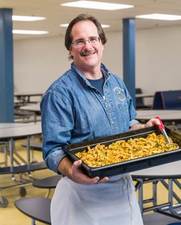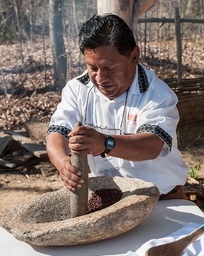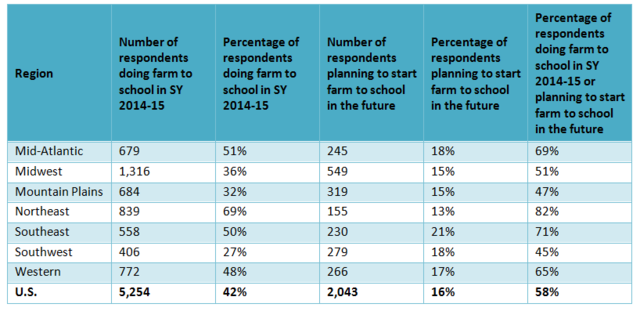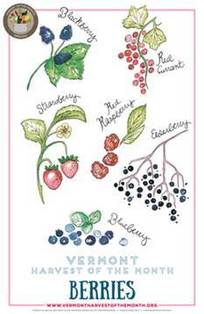|
The sun is out, harvests are in full swing, and summer programs are booming. Take a break from the heat and check out these awesome resources:
 Team Up Thursday Webinar: Integrating local foods
Fruits and
vegetables, milk and cheese, whole grain breads and pastas, beans, meats,
seafood, and poultry - the opportunities for serving local foods in child
nutrition programs are abundant! In the webinar Integrating Local Foods in
Child Nutrition Programs, USDA’s Office of Community Food Systems
will highlight the variety of ways districts across the country are
incorporating local foods. In addition, districts from Vermont and Colorado will share
how they started adding local foods to their meals and how seasonal cycle menus
are now mainstays in their districts.
|

 Community food systems trainings now available in the Professional Standards Database
Are you interested in learning more about farm to school while also meeting your Professional Standards requirements? Several community food systems resources such as the Boulder Valley School District's Garden as Classroom Manual and the Massachusetts Farm to School Cookbook are now available in the Professional Standards Database. Check out this one-stop-shop for farm to school trainings today.
|


Learn more about farm to school in native communities
In April and May, USDA’s Office of Community Food Systems
hosted a four-part webinar series focused on integrating farm to
school strategies in native communities. Each webinar featured a
guest speaker who shared tips, stories, and best practices for
keeping local food traditions alive in child nutrition programs that
serve tribal populations.Watch all four:
|

The Census Scoop: Regional participation by the numbers
Last week, USDA released the raw data from the 2015 Farm to School Census and like many of
you, we’ve been busy pouring over the results. Since the Census website already summarizes
results by respondent, state and nationally, below we’ve taken a look at the results from a regional perspective.

As of school year 2014-15:
- The Midwest had the most number of respondents
participating and planning to participate in farm to school;
- The Northeast had the greatest percentage
of respondents participating in farm to school and more than 80% of respondents were participating or planning to participate in farm to school in the future;
- The Southwest had the lowest number of
respondents participating and also had the lowest percentage of respondents
participating in farm to school; and,
- The Southeast had the greatest percentage of respondents planning to
participate in the future.
The Midwest, Mountain Plains, and Southwest regions have participation rates and expected participation rates
below the national average. These results help inform our training and technical assistance efforts and highlight where farm to school efforts are taking root.
How are you using the Farm to School Census? Tell us!


Celebrate the Season
Promote healthy choices at
summer meals sites! Many state agencies and nonprofit organizations continue
harvest of the month or other educational programs for local items all year
round. Summer sponsors can benefit from free promotional materials like posters,
stickers, sample recipes, or menu graphics, along with recommended activities
and lesson plans that go along with the featured product! Check out harvest of
the month programs in your state or community to find out what types of
resources can complement seasonal summer meals. Visit our Farm to Summer website
for more information on finding, buying, and serving local foods while school
is out.
Already bringing the farm to
your summer meals program? Tell us about it! Send us a photo or two and a
description of your farm to summer program, and we’ll feature model programs
through our E-letter to shine a national spotlight on your programming.
|

Grantee Spotlight
The
Open Door is an FY2016 support service grantee from Gloucester, Massachusetts.
Their project is a community collaboration of local nonprofits and Gloucester
Public Schools to increase student access to fresh fruits and vegetables
through the National School Lunch Program, summer meals, preschool, and after
school suppers through salad bars, taste tests, nutrition education, school
gardens, and local produce acquisition. The Open Door reflects on the work they
did earlier this year:
“In the previous quarter, the
leadership team held two planning meetings. At the second meeting, the
prospective farm to school consultant was introduced to the District’s
assistant superintendent and interviewed by the grant partners. The team has
since drafted an agreement with the consultant.
The Open Door, working with
Backyard Growers, identified four farms within 11 miles and a dairy within 20
miles. The farms have been contacted, and they pledged their involvement for
2016-17 as produce vendors for SFSP and CACFP sites and speakers during school
events.”
Congratulations on the great work!

By Jennifer Gerard, R.D., Center for Ecoliteracy, California Food for California Kids Program Director
What’s your favorite day of the week? For many students in California — it’s Thursday.
On Thursdays, over 1.7 million students in schools that participate
in the California Thursdays program know they’ll be offered a lunch
freshly prepared from California ingredients. California Thursdays is a
celebration of local food, the people who produce and prepare it, and
the significant connections that exist between children, food, and their
environment.
California Thursdays
is also a powerful tool to increase consumption of fresh fruits and
vegetables, stimulate local economies, and decrease the transportation
required for distribution — decreasing emissions and increasing
freshness.
California Thursdays is led by the Center for Ecoliteracy,
a not-for-profit which provides support, inspiration, and resources for
the program. Participating school districts adopt the California
Thursdays program in their own brilliant and unique ways — as you’ll see
in two stories below.
|

|